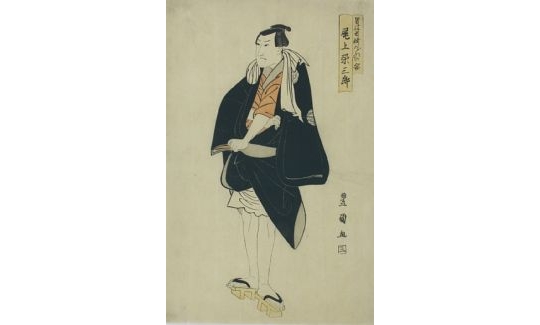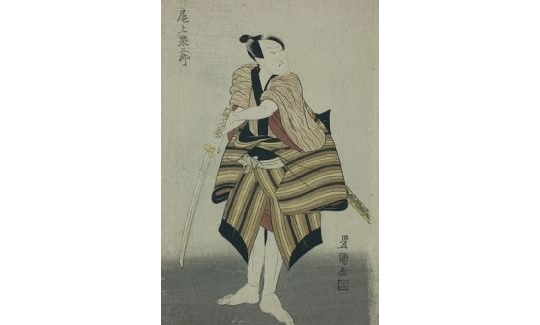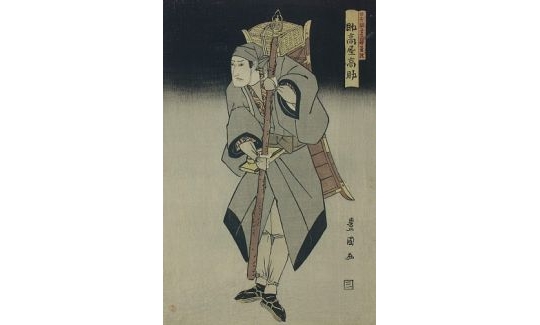Utagawa Toyokuni I (1769-1825) was a designer of woodblock prints of the genre known as ukiyo-e (pictures from the floating world), an illustrator of books, and a painter. In the 1790s he developed an original style of depicting the actors of the Kabuki Theatre, either in scenes from plays, or as portraits. This style became the model for generations of later artists.
Toyokuni I was born in Mishima-cho in the Shiba Quarter of Edo (today Tokyo). He was the son of Kurahashi Gorobei, a famous sculptor of wooden dolls and of figures of Kabuki actors. Throughout his childhood Toyokuni was known as Kumakichi, and later as Kumaemon. At about fourteen years of age he began to study painting at the studio of his neighbour Utagawa Toyoharu (1734-1814), founder of the Utagawa School, who created prints of women and of Kabuki actors, but concentrated mainly on landscapes.
Toyoharu gave Toyokuni the family name Utagawa and the first two syllables of his own name, and chose him to replace himself as head of the school when he retired. The first work Toyokuni signed with this name was an illustration for a novel written in 1786 by Shinratei Manzo. His first woodblock prints, of women, were published one year later. At the end of the 1780s and during the early 1790s, Toyokuni continued to illustrate books and publish prints of women. The exact dates of these works are not known, but in all of them it is evident that his inspiration, the depiction of women - as for all artists of his generation - derived from the prints of Torii Kiyonaga (1752-1815), Kitagawa Utamaro (1753-1806), and Hosoda Eishi (1756-1829).
In the spring of 1794, one month before the artist Toshusai Sharaku (active 1794-1795) published his first portrait print of a Kabuki actor, Toyokuni was invited by the renowned publisher Izumiya Ichibei to prepare prints of Kabuki actors on a pale grey ground. These prints received enormous acclaim, and their publication encouraged Toyokuni to continue producing similar works.
In 1795, Toyokuni's first woodblock print was published, a portrait of an actor. He also enjoyed creating prints depicting two actors in dramatic scenes, and in 1796 he designed a series of such works in a small format (appr. 18 x 37 cm.). In 1797, he produced the first of more than one hundred such prints, this time in a larger format (appr. 25 x 37 cm.). In the first decade of the 19th century, this series increased the reputation of the publisher Nishimuraya Yohachi, Eijudo. From 1795 to 1797 Toyokuni added more than fifty works to the series of "Kabuki Actors on Stage" (Yakusa butai no sugata-e). From that time on Toyokuni's star shone brightly in the Edo sky, giving him the freedom to create prints of women, children, and comic subjects, competing with the works of others of his generation, Utamaro and Eishi. As his fame spread, his confidence grew, and his works became more daring and original, with a conspicuous personal style that is unmistakeable. The Kabuki stage was his inspiration, and since he took great pains to represent the actors' abilities in his prints, their expressions and gestures became more and more fierce and exaggerated. Because of his simple and direct exposition of the actors, woodblock prints have become the most accepted art form in Japan. He once said: "My paintings - they're just what I paint - no more than that!"
As the demand for woodblock prints increased at the beginning of the 19th century, so the number of publishers increased in Edo. Meanwhile, Toyokuni continued to design books and prints of women, though he still focused mainly on Kabuki portraits. He and his students had a virtual monopoly of the subject.
The year in which Toyokuni got married is not known, but we do know that he had two children who also became artists. His daughter (1810-1871) learned painting from him, and was an ukiyo-e artist. She signed her works with the name Kunikame. The son, Naojiro, was a sculptor in wood. It is believed by some that Toyokuni was concerned about his son's empty existence. After Toyokuni died, his son learned to design prints from Toyokuni II (Toyoshige: ca. 1777-1835). He signed several prints that appeared in the 1830s with the name Toyotoshi.
Almost all the artists working at that period whose names began with "Kuni" were Toyokuni's students. His first outstanding pupil was Utagawa Kunimasa (1773-1810), who created more than one hundred prints in the years 1796-1803, most of which were Kabuki portraits.
Toyokuni II joined Toyokuni I's studio in or around 1820. He signed his first works Ichiryusai Toyoshige. In 1824, he was officially adopted by Toyokuni I, and became engaged to the latter's daughter. When Toyokuni I died in 1825, Toyoshige inherited the family name, becoming Toyokuni II. In spite of his youth and lack of experience, he too created paintings of Kabuki actors, beautiful women, and a delightful series of prints of "Eight Views of Famous Places" (Meisho hakkei). Nothing is known of his creations after the mid-1830s. His works are characterized by the delicacy of the faces and bodies, bearing more resemblance to those of Katsukawa Shunsho (1726-1792) than to those of Toyokuni I.
Toyokuni III began his studies with Toyokuni I at the age of fifteen, and received the name Kunisada (1786-1864). In 1808 Kunisada started creating prints of Kabuki actors, but his early works also include prints of beautiful women (bijin-ga), courtesans, and erotic subjects. After Toyokuni I died, both Toyoshige and Kunisada (who actually regarded himself as more worthy of carrying on his master's name) signed themselves as Toyokuni. For this reason, Toyoshige usually appended the name "Kosotei" to his signature, thus differentiating himself from Kunisada.
None of Kunisada's prints that were published by Eijudo were signed as Toyokuni, evidently because he too saw Toyoshige as the natural inheritor of Toyokuni I. Even though he was the most productive and outstanding of Toyokuni I's pupils, he only received official permission from the family to adopt the name Utagawa Toyokuni in February 1844. The official announcement on his prints was: "Kunisada aratame nidai Toyokuni", i.e. "Kunisada has changed his name to Toyokuni II", which is misleading because he was, in fact, Toyokuni III. He probably only received permission to bear his teacher's name in 1843, not in 1835 after Toyoshige's death, because Toyokuni I's widow passed away in 1843, and the family revoked its objections to passing the name on to Kunisada.
The genre of Kabuki actors' portraits that Toyokuni I transmitted to the many artists whose names began with "Kuni" continued to flourish till the 19th century. The woodblock prints of Toyokuni I and Toyokuni III inspired more than two hundred designers of Kabuki prints in Osaka (The Osaka School), and more than half of the traditional Japanese prints are the work of artists of the Utagawa School. Toyokuni I is revered in Japan mainly for his persistent documentation of an important era in the Kabuki Theatre's history. In this field, his influence is manifest in the works of Utagawa Toyokuni III and of Utagawa Kuniyoshi (1798-1861).




